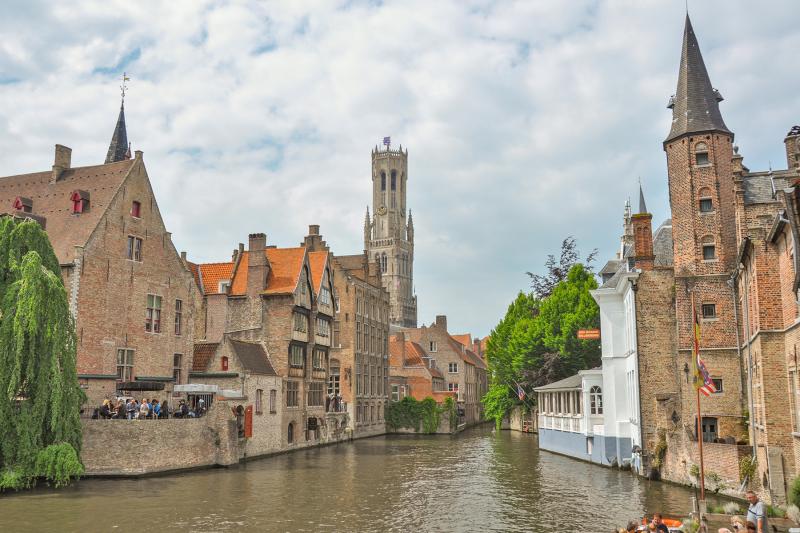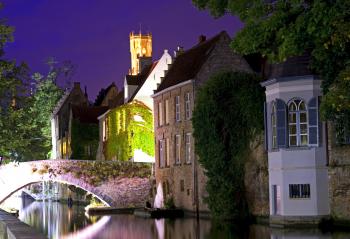Bruges: Pickled in gothic
Appears in the Online Edition, August 2020.
As we've had to postpone our travels because of the pandemic, I believe a weekly dose of travel dreaming can be good medicine. Here's one of my favorite European memories, from Belgium’s most charming city, Bruges. It’s a reminder of the fun that awaits us at the other end of this crisis.
With a smile, the friendly shopkeeper hands me a pharaoh’s head and two hedgehogs. Happily sucking the liquor out of a hedgehog, I walk out of the small chocolate shop with a €3 assortment of Bruges’ best pralines—chocolate treats with sweet fillings.
Belgian chocolate is considered Europe’s finest. And in Bruges, locals boast that their chocolate is the best in Belgium. I’m always tempted by the treats in display windows throughout town. Godiva’s chocolate is thought to be the best big-factory brand, but for quality and service, I drop by one of the many family-run shops. (I pray for cool weather in Belgium because quality chocolate shops close down when it’s hot.)
Free time to explore Bruges always puts me in a fun-loving mood. With Renoir canals, pointy gilded architecture, and stayawhile cafés, the marvelously preserved medieval town is a delight. Where else can you bike along a canal, munch mussels, drink fine monk-made beer, see a Michelangelo statue, and savor heavenly chocolate, all within 300 yards of a bell tower that rings out “Don’t worry, be happy” jingles?
Right from the start, Bruges was a trading center. By the 14th century, it had a population of 35,000 (comparable to London’s) and the most important cloth market in northern Europe. By the 16th century, silt had clogged the harbor and killed the economy. Like so many of Europe’s small-town wonders, Bruges is well-pickled because its economy went sour. But rediscovered by modern-day tourists, Bruges thrives.
The colorful heart of the city, Market Square, is ringed by great old gabled buildings. Since 1300, it has been crowned by a leaning bell tower with a famous set of musical bells. Climbing its 366 steps rewards me with a commanding view and a chance to peek into the carillon room. I time my climb to be there on the quarter hour. That’s when the giant revolving barrel with movable tabs jerks into motion and mechanically rings the 47 bells to play the tune du jour.
Marveling at the medieval contraption doing its musical thing, I meet the carillonist, who explains how the adjustable tabs are moved one way to ring different bells and the other way to make different rhythms. For concerts, the barrel is disengaged, which then engages the manual keyboard. About to leave, I shake his hand . . . and realize it’s deformed by a massive callous making his little finger twice the normal width. Noticing my reaction, he says, “That’s from lots of practice . . . a carillonist plays the keyboard with fists and feet rather than fingers.” Then he reminds me there’s a free concert tonight at eight.
Scampering down the spiral steps, I realize I need to be quick to see the remaining sights and still have time for the brewery tour. Thankfully, everything’s very close.
The Basilica of the Holy Blood is named for its relic of the blood of Christ, which, according to tradition, was brought to Bruges in 1150 after the Second Crusade. The City Hall has the oldest and most sumptuous Gothic hall in the Low Countries. The Gruuthuse Museum is a wealthy brewer’s home, filled with everything from medieval bedpans to a guillotine. The Church of Our Lady has a brick tower that rockets high above anything else in town—standing as a memorial to the power and wealth of Bruges in its heyday. The church holds a delicate Madonna and Child by Michelangelo. Bought with money made from Bruges’ lucrative cloth trade, it’s said to be the only statue by the artist to leave his native Italy during his lifetime.
It’s been a full day, but I’m not quite ready for my hotel room. Stopping by a waffle stand, I get a Belgian waffle to go. Grabbing a wooden bench in the little courtyard under the bell tower, I’m just in time for the evening carillon concert. As the bells ring, I imagine the musician’s massive calloused hands hard at work. Eating the last sweet strawberry on my waffle, I ponder how, even though this Gothic town is a thousand years old, it makes me feel like a kid.
(Rick Steves (www.ricksteves.com) writes European guidebooks, hosts travel shows on public TV and radio, and organizes European tours. This article was adapted from his new book, For the Love of Europe. You can email Rick at rick@ricksteves.com and follow his blog on Facebook..)


